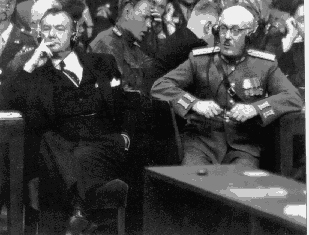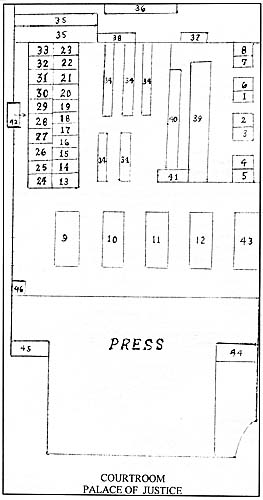The Proceedings of the Trial
 |
Robert H. Jackson and his staff arrived in Nuremberg, Germany in September 1945. The Allies had bombed the city extensively during the last months of World War II but the Palace of Justice and the prison attached to it were still standing. This was the reason Nuremberg was chosen to be the site of the tribunal.
In early October the presiding judges from the participating nations were chosen. Former Attorney General Francis Biddle was selected to judge for the United States with Judge John J. Parker as the American alternate. Sir Geoffrey Lawrence represented Britain, along with Sir Norman Birkett, Henri Donnedieu de Vabres and Robert Falco represented France and Major General I.T. Nikitchenko and A.F. Volchkov represented Russia.
 |
On October 18, 1945 the indictment was handed down at the tribunal’s first session in Berlin. Justice Jackson was to prove Count 1: The Common Plan or Conspiracy, which stated,
“All the defendants, with divers other persons, during a period years preceding 8 May, 1945, participated as leaders, organizers, instigators or accomplices in the formulation or execution of a common plan or conspiracy to commit, or which involved the commission of, Crimes against Peace, War crimes, and Crimes against Humanity, as defined in the Charter of this Tribunal, and, in accordance with the provisions of the charter, are individually responsible for their own acts and for all acts committed by any persons in the execution of such [a] plan or conspiracy” (Gerhart, 355).


The trial began on Tuesday, November 20, 1945 at 10:00 A.M. The first day consisted of the various counsels reading the 21,000-word indictment. Justice Jackson was the first prosecutor to prove his case, being responsible for Count 1, and his opening speech took nearly all of the next day’s session. The main point that Justice Jackson and the American team was trying to prove was that the Nazis were, from the beginning, planning to wage war a war that was illegal under the Kellogg-Briand pact of 1928. Several Nazi organizations were tried during this part of the trial including the Reich Cabinet, the Leadership Corps of the Nazi Party, the SS and the SD, the Gestapo, the SA, and the General Staff and High Command of the German Armed Forces.
On November 22 the documentary case against the Nazi war criminals began. Justice Jackson sought to prove his case through the evidence of documents captured when the Nazis surrendered. One of the most important pieces of evidence was the Hossboch minutes, notes taken by Lieutenant Hossboch at a conference in the Reich Chancellery on November 5, 1937, which outlined Hitler’s plans to wage war in Europe. During this meeting Hitler declared,
 |
“The aim of German policy is the security and the preservation of the nation, and its propagation. This is, consequently, a problem of space…The German question can be solved only by way of force, and this is never without risk” (Gerhart, 365).
On November 29 films of Nazi concentration and prison camps were shown. They were also considered very important evidence in proving the criminal aspects of Nazi organizations. On February 27, 1946 the Allied prosecutors rested their case and the defense for the Nazi war criminals began.
 |
Web page by Amy Suelzle
Revised 12/8/02